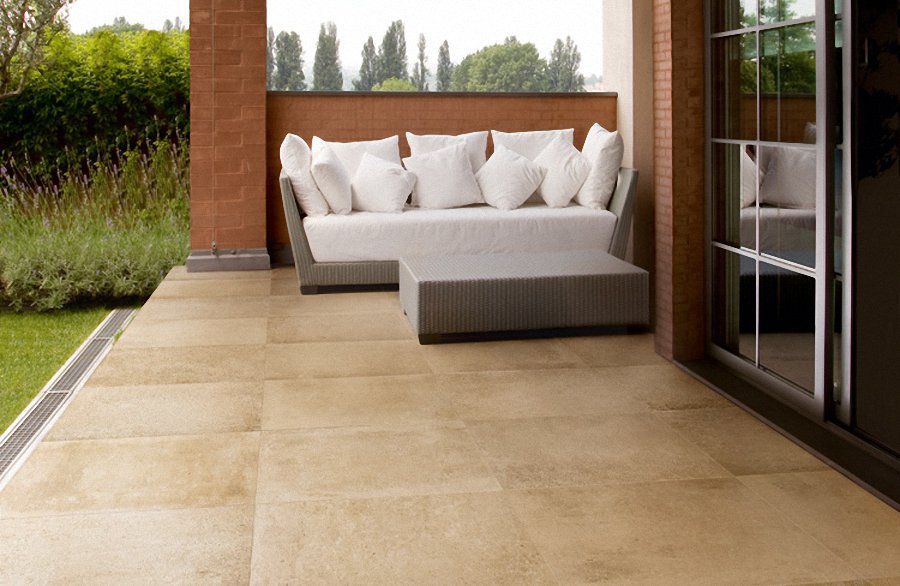Porcelain Ceramic vs Thin Porcelain Tiles
Thin porcelain tiles (TPTs) are making waves in the world of home renovation and design, bringing the porcelain ceramic look back into style in previously unimaginable ways.
The thickness of porcelain tiles have long been their advantage, providing to be reliably durable against scratches and scuffs. Porcelain water’s absorption rate (less than 0.5%) has also lead to it being an almost guaranteed feature in many bathrooms, and even on patios.

TPTs are the thinner, sleeker cousin of classic porcelain tiles. They come in three categories, the first being produced in a similar manner as regular porcelain tiles by dust pressing. Lamina tiles make up the second group – large thin ceramic sheets which can then be cut into smaller sizes. A third category consists of lamina tiles with a special backing, which allows them a certain level of flexibility, meaning that they can be applied to curved surfaces as a single slab.
Like classic porcelain tiles, TPTs offer excellent resistance against cracks and scratches, despite getting as thin 3mm. They too are practically water resistant, and therefore make a great option for bathrooms, as well as exterior detailing – even in areas that are prone to freezing temperatures. But is thinness the only reason for picking TPTs over the less expensive, reputable porcelain tile?
The Porcelain Ceramic Advantage
TPTs are relatively eco-friendly. Most TPTs are manufactured with materials such as clay and mineral oxides, as well as other natural recycled materials. They can also be applied onto existing surfaces, which minimize waste, and reduce the time and cost spent on demolishing previous installations during the renovation process.
Some TPTs are also very resilient to extreme temperatures such as freezing and fire, as well as to moisture, UV rays, chemicals, scratches, stains and fading. TPTs with such resistance can be used outside for anything from doors to pools to patio flooring. In fact, many TPTs come in several different thicknesses to suit different purposes. For instance, according to recently established conventions 3mm TPTs may be used on furniture, 6mm for flooring and facades, 12mm for countertops. Some TPTs like the Coverlam Dock tile (about 19mm) can even be used as a driveway surface!
Another major TPT advantage is the fact that the tiles come in large sizes – so large that they’re sometimes referred to as ‘panel tiles’ or ‘thin porcelain panels’ (though you can get them in smaller sizes, or have larger tiles cut down to custom specifications). While in some places finding a contractor to install TPTs may be difficult, given the fact that these remarkable tiles have been around for less than a decade, many companies, tile suppliers and distribution partners have started offering training to local contractors.
As such, many contractors are now beginning to offer TPT installation at a reasonable rate. When you do find somebody to do the job, TPTs can be installed quickly and with great satisfaction for everybody involved… just think about how quickly and effortlessly a single tile for a countertop, or even a couple 24×24 inch tiles for a driveway can be put into place compared to other materials!
The Return of Porcelain Ceramic Tiles: Style, Color and Finishing
Because TPTs are so versatile, designers and homeowners are more than happy about the fact that you can get them in a range of different styles to suit every need. Currently, the marble imitation look is definitely the most popular option. TPTs can mimic marble to the point where it is often difficult to tell that it is not marble! You can get the marble style in different shades, with soft greys and creams being in favour with most homeowners and designers. That said, TPTs also come in solid colours, and can mimic other classic materials like wood, metal, natural stone and more.
Because TPTs are generally quite large and can fit closely together, the typical grout lines that characterize porcelain tile installations are more or less absent and invisible here. You can also get them in different finishes and textures, whether matte or highly glossy, smooth are rough and “artisanal” looking. Either way, the general absence of grout lines and the sheer size of most TPTs lead to a really clean, modern, luxurious look that can be breathtaking, no matter where you install them.
Conclusion
Because TPTs are so new, standards are still being developed in terms of installation and pricing. However, progress has been made at an astonishing pace in the last couple of years to offer a wider range of TPT styles, installation standards, trained contractors and better prices. Most TPTs are comparable in price to high-quality natural stones like Calacatta and Onyx, though some higher quality TPTs and particular styles can be pricier than quartz.
Read More:
- http://www.sunchinajet.com/
- http://www.reinamarta.com
- http://www.furthepeople.com
- http://www.alldayigame.com
If you’re planning on doing home renovations any time soon, it may be worth it to check out a few tile stores to see just how versatile and advantageous TPTs can be. Don’t forget to shop around and call a few contractors to make sure that they offer TPT installations at a reasonable price. While it was common a few years ago for installations to cost triple than they ought to have, more and more contractors now have the training and the experience to work with TPTs at a good price and in little time.
